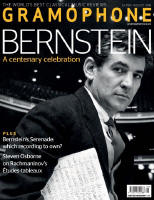Texte paru dans: / Appeared in: |
|
|
Outil de traduction (Très approximatif) |
|
|
Reviewer:
Richard Wigmore If Gluck’s Orfeo was slow to catch on in Vienna, the city of its premiere, it enjoyed repeated success south of the Alps, though not necessarily in its original form. For a production in Parma in 1769 Gluck reshaped the title-role for the soprano castrato Giuseppe Millico (with frequent upward transpositions), simplified the orchestral palette and ditched many of the dances. Five years later this version formed the basis of a Naples production mounted for two Italian stars: Gasparo Pacchierotti, reckoned the finest castrato of the day, and the soprano Anna De Amicis, famed for her vocal agility and dramatic power. Evidently deeming that Euridice’s part needed more brilliance, the theatre management jettisoned the Orfeo-Euridice duet and Euridice’s aria in favour of numbers in a more modishly up-to-date style by one ‘Egidio Lasnel’, anagrammatic pseudonym for an aristocratic dilettante, Diego Naselli. What we have here, then, is a slice of operatic history and something of a pasticcio. The insertion numbers – longer, showier and more generic than the music they replaced – are a stylistic misfit, compromising Gluck’s ideal of ‘beautiful simplicity’. Anyone who knows the 1762 original will notice that Orfeo’s entreaties to the Furies are expanded and (modestly) embellished. They might miss, as I do, the otherworldly timbre of cornetto and chalumeau (unavailable in Naples) in Orfeo’s opening song, and the delicate intricacy of the scoring in ‘Che puro ciel’. And the omission of the final ballet makes the denouement more perfunctory than it need be. The disc’s raison d’être is, of course, Philippe Jaroussky, whose flutey, feminine yet powerful voice may be as near as we can get to a soprano castrato. Gluck’s upward transpositions mean that the role lies perfectly for him. Singing with his customary beauty, Jaroussky is impressive in Orfeo’s heroic resolve in the closing recitative of scene 2 (the Naples version divided the score into seven scenes, played without a break) and pleads eloquently with the Furies – here a duly terrifying bunch. But the grieving ‘Chiamo il mio ben così’ and the rarefied pastoral ‘Che puro ciel’, both taken briskly, sound rather too jaunty and matter-of-fact; nor does Jaroussky plumb the depths of Orfeo’s loneliness and sorrow in ‘Che farò’, transposed up from C to D major and fitted out with trickling pizzicatos for second violins and violas – not the only alteration for Naples that weakens the original. Amanda Forsythe lives up to high expectations as a Euridice both fiery and vulnerable. She and Jaroussky spar vividly as he leads her out of the Underworld; and she is unfazed by the high tessitura and spitfire arpeggios of her subsitute aria, cast in the (in 1774) fashionable form of a slowfast rondò. Emo˝ke Baráth, with a bright, unsoubrettish tone, makes a sparky Amore, though for my taste she overdoes the would-be coquettish lingerings in her aria. The chorus, forwardly recorded (nice), and period orchestra, not least the first oboe, are excellent. Fasolis’s up-tempo direction, at its best in the Orfeo-Furies encounter and most of the final scene, is strong on dramatic urgency, less responsive to the unearthly radiance of the Elysian Fields. At the very least this is an intriguing, offbeat addition to the bulging Orfeo discography. Jaroussky fans, of course, will need no prompting. |
|




